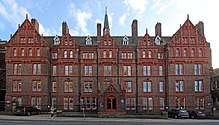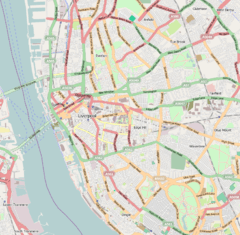Liverpool Royal Infirmary
The Liverpool Royal Infirmary was a health facility in Pembroke Place in Liverpool, England. The building is now used by the University of Liverpool.
| Liverpool Royal Infirmary | |
|---|---|
 Main building on Pembroke Place | |

| |
 Location in Liverpool  Location in Merseyside | |
| Geography | |
| Location | Pembroke Place, Liverpool |
| Coordinates | 53.409°N 2.968°W |
| Organisation | |
| Care system | Public NHS |
| Type | Teaching |
| Affiliated university | University of Liverpool |
| History | |
| Opened | 1743 |
| Closed | 1978 |
History
The infirmary has its origins in a small building on Shaw's Brow which was opened by the 11th Earl of Derby on part of the site which is now occupied by St George's Hall on 25 March 1749.[1]
The second incarnation of the infirmary was designed by John Foster in the Greek Revival style and opened on Brownlow Hill in September 1824.[2] This building was renamed the Liverpool Royal Infirmary after a visit of Queen Victoria to Liverpool in 1851.[2] William Rathbone VI, based on advice from Florence Nightingale, set up the world's first ever district nursing service at this building in 1862.[3]
The foundation stone for a third incarnation of the infirmary, a much larger building, was laid by the 15th Earl of Derby in Pembroke Place on 28 October 1887.[4] The new building, this time designed by Alfred Waterhouse in the Romanesque Revival style, opened in November 1889.[2] The foundation stone for a new out-patient building, which incorporated a large hall which could accommodate up to 200 people, was laid by the 17th Earl of Derby on 7 July 1909.[2] This building was designed by James Doyle and was opened by the 6th Earl of Sefton on 29 March 1911.[1] The infirmary joined the National Health Service in 1948.[5]
After services transferred to the new Royal Liverpool Hospital on Prescot Street, the old building (subsequently referred to as the "Waterhouse Building") closed in 1978.[2] The Waterhouse Building was acquired by the University of Liverpool in 1995 and departments that now use it include the Institute of Psychology, Health and Society.[6] It was used by the BBC for filming Casualty 1907 in 2006.[2]
Gallery
.jpg) The second incarnation of the infirmary
The second incarnation of the infirmary Former ward block at the third incarnation of the infirmary
Former ward block at the third incarnation of the infirmary Ground Floor plan of the third incarnation of the infirmary
Ground Floor plan of the third incarnation of the infirmary First Floor plan of the third incarnation of the infirmary
First Floor plan of the third incarnation of the infirmary
References
- "A History of Dermatology in Liverpool". British Association of Dermatologists. Retrieved 5 October 2018.
- "32 images that reveal Liverpool's original Royal Hospital". Liverpool Echo. 22 June 2015. Retrieved 5 October 2018.
- "History of district nursing". Wordpress. Retrieved 5 October 2018.
- "Liverpool Royal Infirmary". Priory.com. Retrieved 5 October 2018.
- "Liverpool Royal Infirmary". National Archives. Retrieved 5 October 2018.
- "Institute of Psychology, Health and Society" (PDF). University of Liverpool. Retrieved 5 October 2018.
External links
| Wikimedia Commons has media related to Liverpool Royal Infirmary. |